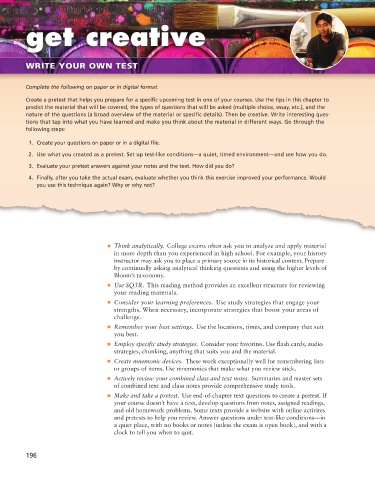Page 234 - Keys To Community College Success
P. 234
get creative
WRITE YOUR OWN TEST
Complete the following on paper or in digital format.
Create a pretest that helps you prepare for a specific upcoming test in one of your courses. Use the tips in this chapter to
predict the material that will be covered, the types of questions that will be asked (multiple choice, essay, etc.), and the
nature of the questions (a broad overview of the material or specific details). Then be creative. Write interesting ques-
tions that tap into what you have learned and make you think about the material in different ways. Go through the
following steps:
1. Create your questions on paper or in a digital file.
2. Use what you created as a pretest. Set up test-like conditions—a quiet, timed environment—and see how you do.
3. Evaluate your pretest answers against your notes and the text. How did you do?
4. Finally, after you take the actual exam, evaluate whether you think this exercise improved your performance. Would
you use this technique again? Why or why not?
■ Think analytically. College exams often ask you to analyze and apply material
in more depth than you experienced in high school. For example, your history
instructor may ask you to place a primary source in its historical context. Prepare
by continually asking analytical thinking questions and using the higher levels of
Bloom’s taxonomy.
■ Use SQ3R. This reading method provides an excellent structure for reviewing
your reading materials.
■ Consider your learning preferences. Use study strategies that engage your
strengths. When necessary, incorporate strategies that boost your areas of
challenge.
■ Remember your best settings. Use the locations, times, and company that suit
you best.
■ Employ specific study strategies. Consider your favorites. Use flash cards, audio
strategies, chunking, anything that suits you and the material.
■ Create mnemonic devices. These work exceptionally well for remembering lists
or groups of items. Use mnemonics that make what you review stick.
■ Actively review your combined class and text notes. Summaries and master sets
of combined text and class notes provide comprehensive study tools.
■ Make and take a pretest. Use end-of-chapter text questions to create a pretest. If
your course doesn’t have a text, develop questions from notes, assigned readings,
and old homework problems. Some texts provide a website with online activites
and pretests to help you review. Answer questions under test-like conditions—in
a quiet place, with no books or notes (unless the exam is open book), and with a
clock to tell you when to quit.
196

